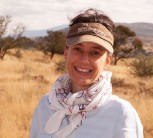Over the past two decades, field trips in search of dung beetles have taken University of Pretoria (UP) doctoral student Christian Deschodt across Southern Africa. But it was a well-trodden walk to fetch his kids from school, a mere 1,5km from his home near Hartbeespoort, that saw him stumble upon an entirely new species.
This was just one of two new species that was recently described by Deschodt, who has been involved in the discovery and description of more than 50 new dung beetle species.
News about the species, named Hathoronthophagus spinosa, spotted on his stroll was announced in Zootaxa, a scientific journal that specialises in updates about the discovery of new species. Deschodt, together with his PhD supervisor, Professor Catherine Sole of UP’s Department of Zoology and Entomology, also placed the species in a new genus, Hathoronthophagus.
“We live near Hartbeespoort Dam on a small piece of land, some 30km from UP’s Hatfield campus,” Deschodt says. “After a morning of research work, I like to stretch my legs by taking a walk to fetch my two children from primary school.”
Never did he imagine that walking along that particular gravel farm road would allow him to combine work with his parental duties. In January 2023, Deschodt set off to fetch his children. It had rained the previous day. About 500 metres into the walk, he spotted a tiny chocolate brown dung beetle less than 5mm in size amid a hoard of common pugnacious ants. No dung was to be seen, as would be expected when dung beetles are around.
Careful not to squash it, he carried the specimen to the school and back home where, after a quick look at it under the microscope, he realised it was the female of a species that he’d never seen before. He named it after ‘Hathor’, an ancient Egyptian deity associated with joy, love, women, fertility and maternal care.
“She was often portrayed as a woman wearing a headdress of cow horns,” Deschodt explains, “which reminded me of the longish horns of Hathoronthophagus spinosa.”
Deschodt has since had no luck in tracking down more specimens, despite having put out lures baited with cattle dung and extensively examining ant nests around Hartbeespoort. He believes this particular species of dung beetle may live in ant nests, and may be providing a mutually beneficial service to its fellow insects. Incidentally, other dung beetles that have antennas with eight segments, like Hathoronthophagus spinosa, have such a relationship with ants. More work will have to be done to confirm this hypothesis.
“I hope that news about this find will at least prompt other experts working in Southern Africa to explore the relatively unknown relationship between ants and dung beetles more intensively,” he says.
There are about 500 species of dung beetle in South Africa, and more than 700 in all Southern African countries, including South Africa, Botswana, Namibia, southern Mozambique and Zimbabwe. According to Deschodt, this diversity is partly due to South Africa’s hugely varied geography and range of vegetation types, from fynbos to succulents, thickets and savannas.
He says many species of dung beetles are specific about the type of dung they use. For instance, some are only found using elephant or rhinoceros dung. For his PhD, Deschodt is working on a flightless genus found in the arid parts of Namibia and western South Africa that only keeps to rock hyrax (‘dassie’) dung pellets.
It is also a fallacy that dung beetles only feed on faeces, despite what their common name might infer. Some species have been seen scavenging on dead frogs and chicken livers, or feeding on different types of mushrooms.
In his latest paper, which also appeared in in Zootaxa, Deschodt described yet another new species. Onthophagus pragtig most likely only feeds on the innards of dead millipedes. It is one of 20 species that is part of a small group of dung beetles in the genus Onthophagus. All other species in this group are known to prefer feeding on the soft internal organs (or viscera) of dead millipedes.
“These beetles are small and about the width of a millipede in cross-section,” Deschodt explains. “One after the other, they enter a millipede’s carcass via any breach in the body they can find. I’ve seen some sitting tightly packed together in a carcass, almost like a string of dark pearls. They scrape soft edible tissue off, then form these into small balls to feed on later.”
"Onthophagus pragtig will form a ball with the viscera of a dead millipede and bury it directly under the millipede carcass. For dung beetles forming a ball to provision their offspring from something other than dung is already unique, but forming it from the innards of a millipede is quite extraordinary. It is known that millipedes have hydrogen cyanide, hydrocloric acid, hydroquinones, benzoquinones, alkaloids, and phenols inside of them", he says.
Most species range in colour, from black, brown and orange to shiny coppery shades. Some can be metallic blue, green and red, while only a few have coloured spots or markings. The coppery red metallic sheen of Onthophagus pragtig makes it particularly beautiful, and almost jewel-like, Deschodt says.
“The epithet ‘pragtig’ is Afrikaans for ‘splendid’,” he explains. “It links this species with some other very closely related species within the same group, namely Onthophagus splendidus and Onthophagus splendidoides. All of them seem to prefer sandy soils.”
Examples of Onthophagus pragtig have been collected in Limpopo and the Northern Cape, and was described from specimens that are part of collections held at UP and the Ditsong Museum of Natural History in Pretoria. The first known specimens of Onthophagus pragtig were collected by Deschodt’s mentor, Professor Clarke Scholtz, who, before his retirement, was associated with UP’s Department of Zoology and Entomology for many years. In the early 2000s, Deschodt was part of Prof Scholtz’ research team that investigated the impact of livestock dips on dung beetle diversity in South Africa.
“It’s difficult to study species like Onthophagus pragtig that do not have a specific relationship to dung”, Deschodt says, “as they are not readily attracted to faeces bait as ‘typical’ dung beetles are”. He hopes the description of this beautiful new species will encourage other scarab experts in Africa to explore carrion and millipede carcasses that may have been trampled on.
Click on the infographic in the sidebar to learn more about the importance of dung beetles or click on the gallery to view pictures of both species.
*Disclaimer: Banner image displays a typical image of what dung beetles normally do with rolling a ball with dung. However, both of these species don't do that. The image is for illustrative purposes only to differentiate the species in the discoveries this article describes from other species.
Christian Deschodt and Prof Catherine Sole
November 13, 2024

Christian Deschodt is a PhD student in the University of Pretoria’s (UP) Invertebrate Biosystematics and Conservation Group under the supervision of Professor Catherine Sole. He completed a master’s degree at Rhodes University and has been doing research at UP for 15 years, and since 2020 as a doctoral student.
Deschodt has expert knowledge of the southern African Scarabaeinae, more widely known as the dung beetle.
As to how his field of research contributes to the betterment of the world, he says: “Without dung beetles, within one year, the earth would literally be knee-deep in excreted matter. Dung beetles are of extreme ecological importance, and can be used as indicators of environmental health. I hope that my knowledge will help us to better understand the natural distribution of the Scarabaeinae so we can improve or concentrate our conservation efforts of new or established reserves and ecosystems where needed.”
In the recent past, Deschodt has authored or co-authored 41 peer-reviewed papers in local and international journals, as well as a peer-reviewed book, on taxonomy and ecology. He is part of the International Union for Conservation of Nature’s specialist group on dung beetles which assesses the southern African fauna for the IUCN’s Red List of Threatened Species.
Outside his academic work, Deschodt is a beekeeper and keeps a few head of Braunvieh cattle. He has an extensive collection of books on the natural history of Africa and southern Africa, some of which form part of the rare Africana book collection.

Professor Catherine Sole's research is driven by the power of molecular techniques in testing evolutionary processes at various levels: population, species and higher taxa with special focus on invertebrates. She aims to find common evolutionary patterns in different taxa that reflect landscape and phylogenetic changes; and linking them to climatic, biogeographic and geological changes.
She is affiliated with the University of Pretoria Forestry and Agricultural Biotechnology Institute (FABI) to which she contributes entomological capacity and expertise.
 Story
Story
Cricket à la king? How about a yellow mealworm burger? Foods that may previously have evoked a ‘yuck’ response are now firmly on the menu. Research into edible insects by the Department of Zoology and Entomology at the University of Pretoria (UP) is exploring how to rear and harvest this food of the future.
 Story
Story
A single query to ChatGPT uses as much electricity as burning a light bulb for about 20 minutes. Multiply that by the millions of requests that this artificial intelligence (AI) chatbot receives each day, and the environmental impact is ominous.
 Story
Story
University of Pretoria (UP) researchers have found that the antioxidant content of certain types of tea can be likened to that found in recommended portions of fruit and vegetables.
Copyright © University of Pretoria 2025. All rights reserved.
Get Social With Us
Download the UP Mobile App